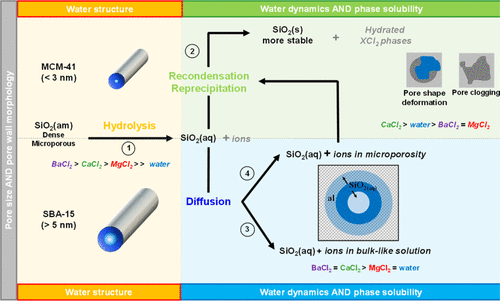当前位置:
X-MOL 学术
›
J. Phys. Chem. C
›
论文详情
Our official English website, www.x-mol.net, welcomes your feedback! (Note: you will need to create a separate account there.)
Underlying Processes Driving the Evolution of Nanoporous Silica in Water and Electrolyte Solutions
The Journal of Physical Chemistry C ( IF 3.7 ) Pub Date : 2020-06-11 , DOI: 10.1021/acs.jpcc.0c00911 Markus Baum 1 , Francois Rieutord 2 , Diane Rébiscoul 1
The Journal of Physical Chemistry C ( IF 3.7 ) Pub Date : 2020-06-11 , DOI: 10.1021/acs.jpcc.0c00911 Markus Baum 1 , Francois Rieutord 2 , Diane Rébiscoul 1
Affiliation

|
In this study, we related the alteration of mesoporous materials in aqueous solutions to the properties of confined water in the presence of ions, that is, its structure and its dynamics. To reach this goal, we have determined and quantified the evolution of the morphology of hexagonal mesoporous silica-based materials, that is, MCM-41 (mean pore size of 2.9 nm and dense pore wall) and SBA-15 (mean pore size of 6.8 nm and microporous pore wall), during their alteration in water and electrolyte solutions with ions presenting various kosmotropic properties ([XCl2] = 1 M and X = Ba, Ca, Mg) at 50 °C by in situ small and wide angle X-ray scattering. The experimental results and the calculated small-angle X-ray scattering spectra have demonstrated that the alteration behavior is strongly dependent on the type of silica and the water properties (water dynamics at a picosecond time scale and water structure) related to the confinement size, the nature of the cations, and their surface ion excesses. For MCM-41 silica, having reduced water dynamics, the alteration behavior is mainly driven by silica hydrolysis—recondensation/precipitation processes leading to a pore deformation and a possible precipitation of XCl2 metastable phases partially clogging the pores. In case of SBA-15, its alteration behavior in aqueous solutions starts with an initial increase of the pore size and the formation of an alteration layer within its microporosity which grows following a diffusive process of the solution. Inside the microporosity, similar alteration processes to MCM-41 silica occur. These recondensation/precipitation processes may continue until a thermodynamically stable silica phase is formed. The results obtained within the scope of this work revealed the importance of the influence of the dynamics and the structure of water in chemical reactions taking place in confined media filled with water and ions.
中文翻译:

推动纳米多孔二氧化硅在水和电解质溶液中演化的基本过程
在这项研究中,我们将水溶液中介孔材料的变化与离子存在下承压水的性质(即其结构和动力学)相关联。为了达到这个目标,我们确定并量化了六方介孔二氧化硅基材料的形态演变,即MCM-41(平均孔径为2.9 nm和致密孔壁)和SBA-15(平均孔径为6.8 nm和微孔壁),在水和电解质溶液中发生改变时,离子会表现出各种同调性([XCl 2] = 1 M,X = Ba,Ca,Mg)在50°C时通过原位小角度和广角X射线散射进行分析。实验结果和计算得出的小角X射线散射光谱表明,蚀变行为很大程度上取决于二氧化硅的类型以及与水位大小有关的水属性(皮秒时间尺度的水动力学和水结构),阳离子的性质及其表面离子过量。对于水动力学降低的MCM-41二氧化硅,其变化行为主要是由二氧化硅水解驱动的-缩合/沉淀过程导致孔隙变形和XCl 2可能沉淀亚稳相部分堵塞毛孔。在SBA-15的情况下,其在水溶液中的改变行为始于孔径的最初增加和在其微孔内形成改变层,该改变层随着溶液的扩散过程而增长。在微孔内部,发生了与MCM-41二氧化硅相似的改变过程。这些再冷凝/沉淀过程可以继续进行,直到形成热力学稳定的二氧化硅相为止。在这项工作范围内获得的结果表明,在充满水和离子的密闭介质中发生的化学反应中,水的动力学和结构影响的重要性。
更新日期:2020-07-09
中文翻译:

推动纳米多孔二氧化硅在水和电解质溶液中演化的基本过程
在这项研究中,我们将水溶液中介孔材料的变化与离子存在下承压水的性质(即其结构和动力学)相关联。为了达到这个目标,我们确定并量化了六方介孔二氧化硅基材料的形态演变,即MCM-41(平均孔径为2.9 nm和致密孔壁)和SBA-15(平均孔径为6.8 nm和微孔壁),在水和电解质溶液中发生改变时,离子会表现出各种同调性([XCl 2] = 1 M,X = Ba,Ca,Mg)在50°C时通过原位小角度和广角X射线散射进行分析。实验结果和计算得出的小角X射线散射光谱表明,蚀变行为很大程度上取决于二氧化硅的类型以及与水位大小有关的水属性(皮秒时间尺度的水动力学和水结构),阳离子的性质及其表面离子过量。对于水动力学降低的MCM-41二氧化硅,其变化行为主要是由二氧化硅水解驱动的-缩合/沉淀过程导致孔隙变形和XCl 2可能沉淀亚稳相部分堵塞毛孔。在SBA-15的情况下,其在水溶液中的改变行为始于孔径的最初增加和在其微孔内形成改变层,该改变层随着溶液的扩散过程而增长。在微孔内部,发生了与MCM-41二氧化硅相似的改变过程。这些再冷凝/沉淀过程可以继续进行,直到形成热力学稳定的二氧化硅相为止。在这项工作范围内获得的结果表明,在充满水和离子的密闭介质中发生的化学反应中,水的动力学和结构影响的重要性。


























 京公网安备 11010802027423号
京公网安备 11010802027423号